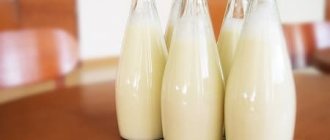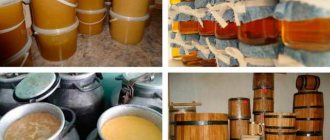Useful tips
By properly storing food, you not only protect it from spoilage, but also preserve its nutritional and biological value.
.
Possession of the necessary information on food storage also protects against poisoning.
Always follow the expiration dates and storage conditions of a particular product, which are indicated on the packaging.
It is recommended to store dairy products such as milk, kefir, sour cream or cream in a clean, sealed container and in a place out of direct sunlight.
In closed containers, these products will not absorb odors from the environment, and thus their taste will not be impaired.
Here you will learn how to properly store dairy products,
and how long each of them is stored.
How long can milk be stored?
© filipfoto/Getty Images Pro
The shelf life of milk is influenced by several factors: milk processing, storage location and packaging.
For example, fresh milk can be stored in the refrigerator for up to 48 hours.
, and
boiled can be kept in the refrigerator for up to 3 days
.
At room temperature
fresh milk is stored
for up to 10 hours
, and boiled milk
for 18 hours
.
You can keep milk fresh for the longest time in a Tetra Pak.
.
This packaging allows milk to increase its shelf life up to 6 months
.
It is worth noting that milk can be of several types, and each of them has its own expiration date.
Let's look at it in detail:
In the freezer
If you want to store a large amount of drink for a long time, it is best to use the freezer. Place the milk in a suitable container in advance. Sealed bags, plastic bottles, and ice trays are suitable. Never fill the container completely, as when the ambient temperature drops, the liquid expands and damages the container. For some types of milk (including breast milk), you need to prepare special containers.
Frozen milk can be stored for 4 months. It should not be reheated in a microwave oven or re-frozen. It is advisable to use a refrigerator for defrosting. Place the container on the shelf and wait a few hours.
Baked milk storage
© Julia_Sudnitskaya / Getty Images Pro
* In Rus', baked milk was prepared in clay dishes, which were placed in the oven.
* Baked milk is very useful for people with weak bodies, as well as for children.
* It is worth noting that baked milk has a high content of fat (up to 6%) and calcium.
* This milk can be stored for approximately the same amount of time as boiled milk. It should be stored in the refrigerator at temperatures up to +8 C.
* If there is no refrigerator or it is broken, the bowl with baked milk should be placed in a wider container filled with cold water and covered with a damp cloth. Keep away from sunlight.
*Baked milk can be prepared at home. There are 3 methods: in the oven, in a slow cooker and in a thermos. But the main thing is to keep the milk at a temperature of 85 to 95 degrees for at least 1.5 hours.
* By adding a spoonful of sour cream to baked milk, you will get an equally healthy product - fermented baked milk.
How to prepare baked milk? (video)
Useful properties and contraindications
The popularity of milk as a food product is associated with its positive effect on the human body.
Main advantages:
- It is a natural source of digestible calcium. Improves the condition of hair and nails, strengthens bones.
- Promotes healthy sleep and calms the nervous system.
- Helps in the fight against colds and strengthens the immune system.
- Reduces the risk of cancer and diabetes.
- Fights hunger and can be used in diets and healthy eating.
- It has a positive effect on the functioning of the gastrointestinal tract, recommended for heartburn, gastritis and ulcers.
- Beneficial for children's bodies.
Despite its positive qualities, the product can negatively affect a person. It is contraindicated for people with a deficiency of lactase, an enzyme that breaks down milk sugar, as it leads to stomach upset.
Milk can cause allergic reactions. It should not be used by patients with deposits in the vessels and the presence of kidney stones.
How to store pasteurized milk?
To ensure that milk retains as many nutrients, vitamins and minerals as possible, a pasteurization process is used.
© Tiero
The main thing in this process is that the milk must have a temperature of at least 70 C
.
* Before processing milk, it is freed from large impurities using filtering.
* During pasteurization, pathogenic and lactic acid bacteria are killed
, which play a role in souring milk and turning it into curdled milk.
* During boiling, milk, although it loses some of its protein, as well as some vitamins and minerals, is not significant.
© smartin69 / Getty Images Pro
In a whole (not unpacked) package or bottle, pasteurized milk can be stored for as long as indicated on the package itself (2-3 weeks). But in an open package, the shelf life of milk is reduced to 2 days.
It is worth noting that after opening the package, it is better to pour the milk into a glass container
, which should first be doused with boiling water. After you have poured the milk into the container, cover it with a tight lid.
Also pour milk purchased from the market into a glass container.
* Do not store milk in plastic containers.
Ultra pasteurization
Today, the industry uses the ultra-pasteurization method. After it, milk retains many useful substances, which decrease over time during pasteurization.
Ultrapasteurization of milk (video)
Composition and varieties
The amount of nutrients varies depending on the breed of the animal, its age and health status, feeding and housing conditions. Cow's milk contains per 100 g:
- water - 89.2 g;
- carbohydrates - 4.8 g;
- fats - 2 g;
- proteins - 3.3 g;
- calcium - 120 mcg;
- potassium - 140 mcg;
- sodium - 47 mcg;
- minerals (iron, magnesium, phosphorus, zinc, copper, selenium, fluorine) - 108.9 mcg;
- vitamin A - 28 mcg;
- beta-carotene - 7 mcg;
- vitamins (C, E, K, B1-6, B9, B12) - 22.9 mcg.
Calorie content, depending on the processing method and fat content, is 25–85 kcal.
The shelf life of milk depends on the type of milk raw material, methods of its processing and packaging of the final product. According to the requirements of state standards, raw milk can be divided into:
- Whole. Natural strained milk that preserves the natural balance of nutrients.
- Low fat. Cream is removed from such milk using separation. It is difficult to distinguish its taste from whole meat, but its nutritional value is reduced by 2 times.
- Normalized. The separator separates the cream and skimmed liquid (reverse). The product is then mixed with whole milk to obtain the required fat content.
- Refurbished. It is made from concentrate or milk powder by mixing with water.
When choosing milk, you often have to balance between usefulness and the ability to keep fresh for a long time.
Determining the delay
In order not to purchase expired goods in a supermarket, market or from hand, adhere to the following rules:
- There should be no unpleasant or strange odor (if purchased steamed or unpasteurized).
- Choose the freshest product with a recent production date (Promotions most often sell expired products).
- When buying at the market, ask the merchant for certificates, look at the sanitary conditions of the point.
- Consumer packaging must not be deformed or swollen.
- Between whole and normalized, it is preferable to choose whole selected.
Coconut
To get a natural drink, coconut pulp is crushed and then water is added to it. Its smell and taste are neutral, but coconut milk contains a large amount of useful substances. It can be purchased in stores in cans or paper packages. In a closed container it will keep for a long time, but after opening the package it should be consumed within 1 day.
Types of packaging
Products sold in plastic bags or cardboard bags are most often pasteurized. Pasteurized milk can be stored for no more than 3 to 5 days.
Products that have undergone ultra-pasteurization and sterilization are bottled under completely sterile conditions. After such treatment, milk is stored only in special packaging made using Tetra-Pak technology. They provide storage conditions under which the product retains all its qualities for up to six months. Ultra-pasteurized products should not be purchased in containers made of polyethylene and cardboard.
Legal requirements
The period of time after which a food product cannot be eaten, even if all storage conditions are met, is called the expiration date. It guarantees that if the product was stored correctly, it will not cause any harm to health during this period.
There is another period - storage. It is less than the expiration date. During this period, the product retains the same qualities that were inherent in it immediately after production.
On June 16, 1997, the Government of the Russian Federation adopted Resolution No. 720 listing goods that cannot be used after the expiration date. Accordingly, this information must be printed on consumer packaging.
The section “Dairy Products” contains such items as cow’s milk, baked milk, and whole milk products. Therefore, the manufacturer is obliged to put expiration dates on the packaging. Due to the inclusion of this product in the list of Decree No. 720, it cannot be eaten unless the expiration date is indicated.
Based on Article 473 of the Civil Code of the Russian Federation, this period begins from the date of production. For example, if a product was produced on the 19th and its expiration date is 5 days, then the end date of the period will be the 23rd.
Is it possible to freeze
Frozen milk will be stored for a long time. Fresh food that has not been processed thermally or chemically can be frozen for a long period of up to 3-4 months. At the same time, all beneficial properties will be preserved. Store-bought milk can also be frozen, but for no more than 6 weeks. It is worth choosing a temperature in the range of -15-22 °C. To ensure that there are no clots in the product after defrosting, the fat content of the drink should be low.
To ensure that a valuable product does not lose its beneficial properties and is always of high quality, it is necessary to ensure proper storage of milk. By preserving its beneficial qualities, a person can strengthen his immunity. And it’s impossible to count how many delicious dishes and products based on it are on sale and for self-cooking.
How do you like the article?
Adviсe
To keep milk fresh for as long as possible, you just need to apply some basic principles. Here are some helpful tips and tricks to get the most from your milk:
In the supermarket
- The time factor is the interval between when you took the milk from the refrigerator in the store and when you put it in your home. When shopping at the store, milk should be the last thing you add to your cart. This reduces the length of time the product stays in a warm environment and does not have time to warm up. After purchasing, refrigerate the milk as quickly as possible and store it at a temperature between 0°C and 4°C.
- Check the expiration date on the package and select the product with the furthest date. On a long trip, before you arrive home, it is convenient to use a special container - a cooler bag for storing food in the car.
At home
- Once opened, the milk is safe to consume for up to 3 days . It is better to buy more often in small packages and smaller quantities than to keep open large containers in the refrigerator for a long time;
- Open the milk in the same order in which you bought them;
- Keep milk covered and away from strong-smelling foods in the refrigerator—milk can absorb these odors;
- Place the milk on the refrigerator shelves where it is colder;
- If possible, leave milk in its original packaging to protect its flavor and nutritional value;
- Avoid exposing milk to light as light destroys some vitamins such as vitamin D and riboflavin.
- Avoid milk spoilage by pouring unused milk back into the original container from the jug.
- If pasteurized milk or canned milk is opened, its shelf life will be shortened. Therefore, pre-cool foods. Place unused canned milk into clean, opaque, airtight containers. Such dairy products must be used within 3 days from the moment the package is opened.
- Powdered milk (milk powder) can be stored for up to 6 months in a cool, dry place. After opening the package, the powder should be used within 1 month. From the moment you dilute the powder with water, store this milk in the refrigerator for 3 days.
- Milk can be frozen for up to 6 weeks. This method will not have any effect on its taste and nutritional quality. After thawing, clumps may appear and the smooth texture may be lost. It is better to freeze partially or completely skimmed milk than whole milk (3.25%). Milk should be defrosted in the refrigerator. If the thawed milk separates, beat it in an electric mixer or blender.
- Condensed milk can be frozen in an airtight container for up to 6 weeks without any side effects.
Note: If you are freezing foods such as soups or stews, add milk after the food has been completely defrosted and after it has been reheated.
Marking according to GOST
Marking on consumer packaging is applied in accordance with GOST R 51074. This document lists the information that the manufacturer applies to the packaging. Among other things, the expiration date is also indicated.
The same GOST states that if a product must be kept under certain temperature conditions, then storage conditions are also applied to the consumer packaging. Accordingly, the package (box, bottle, etc.) of milk indicates at what temperature it must be kept before and after opening.
Boiling
After boiling, milk can be stored for 3 to 4 days. And if you lower the temperature to 0 degrees - up to 7 days.
Raw, unheated milk contains many different bacteria that are killed when boiled. Therefore, it is recommended to give only processed food to children.
It is imperative to boil products purchased from strangers, even if they verbally guarantee its quality. There are cases where people, drinking raw milk, became infected with such a dangerous disease as brucellosis. This infection is transmitted from a sick animal and affects the organs and central nervous system of humans. Boiling completely kills pathogenic microorganisms, and such a product will be safe to consume.
But there is also a downside to this. Products that have been exposed to high temperatures are no longer as healthy as fresh ones. During the boiling process, protein remains in large quantities on the walls of the container. Changes concern calcium and phosphorus - it becomes more difficult for the body to absorb them. With prolonged heating above +100°C, vitamins C and D decompose, and a significant part of the protein is also lost.











